 |
|

|
 |
TABLE of CONTENTS
|
Toward Zero Deaths: 15 years of saving lives |
By Sue Roe

The TZD program has involved the 4 “Es” over the past 15 years to improve safety on Minnesota roadways. |
Since 2003, Toward Zero Deaths has championed the cause of reducing traffic deaths in Minnesota. Using an interdisciplinary approach that involves engineering, education, enforcement and emergency medical and trauma services, this cooperative work has reduced traffic deaths by 45 percent in the past 15 years. Statewide seat belt use has also risen from 87 percent in 2008 to 92 percent.
“The TZD program works well because it operates under two basic goals,” said Kristine Hernandez, statewide TZD program coordinator. “We’re engaging traffic-relating stakeholders at all levels, but especially at the local grassroots level, and we’re focusing on effective countermeasures and sharing those statewide.”
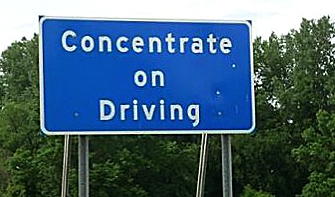
This sign is still on Hwy 52, which was the first TZD effort to add several signs along the corridor from the Twin Cities to Rochester. The corridor was overrepresented in fatality crashes. In 2017, the crash rate for severe crashes decreased more than 60 percent from 2003. MnDOT file photo |
MnDOT works with the departments of public safety and health and other public and private stakeholders to find better solutions to the problems of serious injuries and fatal crashes using data driven approaches that are tailored to community needs.
“There hasn’t been one magical accomplishment that has reduced traffic-related deaths,” said Hernandez. “It’s been the partnerships working together. They have conversations about barriers to getting their work done and working together to reduce or eliminate those barriers. They get an understanding of what and why the other “Es” do what they do and can communicate or explain that to others in the community.”
In the past 15 years, these are some of the accomplishments of TZD’s 4 "Es:"
Engineering
- Cable median barrier – Today, there are more than 700 miles of high tension cable median barrier, which has helped reduce fatal head-on crashes by 95 percent.
- Roundabouts – Removed right angle crashes and reduced fatal crashes by 86 percent and injury crashes by 42 percent.
- Reduced Conflict Intersections – 100 percent reduction in fatal and serious injury crashes; 77 percent reduction in right angle crashes.
- Rumble/mumble strips – 44 percent reduction in fatal, injury and cross-over crashes since 2012,
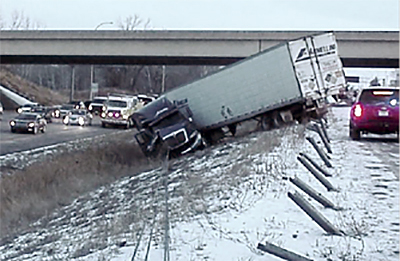
The cable median barrier installed on this section of road stopped this semi from entering the opposite lane of traffic. Although cable median barrier isn’t engineered for such a large impact, it still has the potential to stop a semi, under certain conditions. Installation of more than 700 miles of cable median barrier has helped reduce fatal head-on crashes by 95 percent. MnDOT file photo |
when the new policy of placing centerline rumbles on all rural, undivided roadways with a posted speed limit of 55 and higher went into effect.
Emergency Medical and Trauma Services
- A statewide trauma system was established, bringing more Minnesota residents closer to hospitals that can handle traffic crash victim injuries. Today, 99 percent of Minnesotans are within 60 minutes of a level 1 or level 2 trauma system.
- Aeromedical auto launch automatically launches a helicopter when a 911 call is received, instead of waiting for responders to arrive on the scene. This reduces response time to get medical help, especially in greater Minnesota.
Enforcement
- Law enforcement now has highly visible, targeted efforts including seat belt compliance and distracted driving.
- Coordinated efforts between state and local authorities provide multi-state and border to border cooperation.
- Motorcycle safety training – In 1986, 375 students took the training. In 2017, nearly 170,000 students took the training. Advanced riding classes were also added.
Courts and Legislation
- DWI courts lowered the rate of repeat offenders from 78 to 31 percent.
- Passage of stronger traffic safety policies related to seat belt use, texting while driving, ignition interlock, graduated driving licensing, impaired driving, and speeding in work zones.
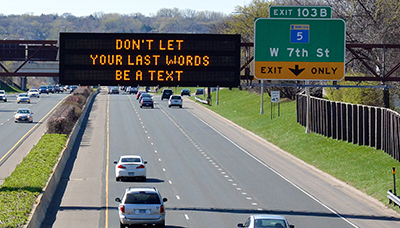
“Don’t let your last words be a text” is one of the Message Monday messages seen on dynamic messaging signs across the state to bring attention to safe driving. Photo by Kristi Loobeek |
Despite the successes of the past 15 years, challenges persist, including a plateau in the number traffic deaths and reaching the ‘core’ risk-takers, who are young, adult males, ages 16-34.
“This group is overrepresented in our fatality numbers. They tend to not buckle up, speed and engage in other risky driving behaviors,” Hernandez said.
The young, adult male target group was a main reason for starting the Monday Message that are seen on dynamic messaging signs across the state.
Other challenges for TZD include motorcyclists who don’t wear helmets, unintended pedestrians, not driving for certain road and weather conditions, not securing loads and not driving a well-maintained vehicle. These are the challenges that are outside the main behaviors of lack of seat belt use, driving distracted, drowsy, drunk or drugged and speeding.
Hernandez said TZD continues to work on innovative approaches that can become best practices to further reduce deaths and serious injury crashes. One of those efforts is to change the culture of traffic safety in the state. She pointed to a three-year pilot project in Park Rapids that is focused on changing driving behaviors.
“If we truly want to get to zero traffic deaths, traffic safety needs to be ingrained into our culture,” she said. “It’s much like what happened with seat belt use, recycling and advocating for no smoking. We can’t educate or enforce our way to zero traffic-related deaths. People have to start thinking about the deaths and injuries that result from behaviors such as speeding and distracted and drunk driving. We are all in this together for our communities, friends and families.”
Hernandez said future steps for TZD include:
- MnDOT will paint quarter markers along roadways, so State Patrol aircraft can also help spot speeders and can accurately call in their location.
- Increase active statewide TZD coalitions to all 87 counties. Currently 29 counties do not have coalitions.
- Decide how automated and connected vehicles will fit into traffic safety.
TZD’s goal for 2020 is 300 or fewer traffic related-deaths and 850 or fewer traffic-related serious injuries.
Read more information on TZD. |
 |
|

|
 |
TABLE of CONTENTS
 |
Interstate 35, Hwy 14 bridge project replaces 12 bridges in key Southeast Minnesota corridor |
By Mike Dougherty, District 6 public engagement and communications director
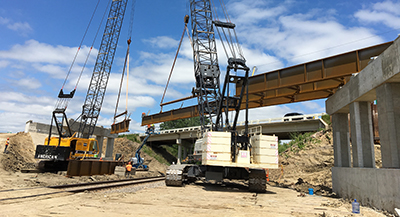
Crews setting beams on bridge over Union Pacific Railroad south of Owatonna. It is part of the Interstate 35, Hwy 14 bridge project. Photo by Tory Thompson |
District 6 is wrapping up a two-year project that started construction in 2017 as a plan to replace 10 bridges on Interstate 35 and Hwy 14 south of Owatonna and expanded to an additional two bridges after a motorist damaged them near the work zone in the spring of 2017.
The Steele County Bridges project was a design-build effort. It’s expected to wrap up next week when traffic opens up in both the northbound and southbound lanes of I-35. Traffic on Hwy 14 was returned to its respective lanes earlier this month.
The plan originally started as an effort to replace nine bridges. District 6 arranged funding to add the 10th to the replacement list and began the project in 2017 with that focus – three in each direction on I-35 and two in each direction on Hwy 14. All of the bridges are near the junction of Hwy 14 and I-35, south and east of Owatonna.
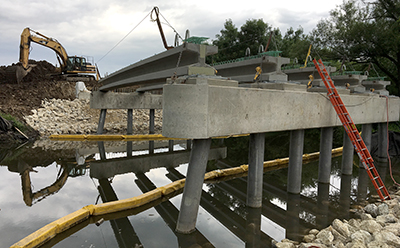
Exposed piles that were filled with concrete were used on the I-35 bridge over Turtle Creek. Photo by Tory Thompson |
The corridor is a busy crossroads in District 6, mixing local traffic with travelers and freight haulers. I-35 has an average daily traffic count of 35,000 vehicles, while that stretch of Hwy 14 to the east has an average traffic count of 14,000 vehicles. Traffic was routed in each direction in adjacent lanes on the northbound lanes in 2017 on I-35, while the southbound bridges were replaced and traffic used the westbound lanes of Hwy 14, while the eastbound bridges were replaced. Then the lanes were reversed for the replacements in 2018.
The big wrinkle in the project occurred April 1, 2017, when a southbound I-35 truck carrying a boom lift in a trailer struck the bottom of two bridges south of Hwy 14, damaging both to the level that MnDOT decided it was most cost effective to replace much of the bridge. So MnDOT designed these bridges and negotiated them into the contract. The piers and abutments of the bridges at Steele County Road 18 and 31 were retained, but the deck and railing were replaced.
Bridges along I-35 over the Straight River and Turtle Creek are not navigable rivers, so piles that were filled with concrete, but not encased with concrete on the exterior were used, which is what’s normally done with waterways that have boats.
MnDOT is also testing a different coating of the bridge deck rebar, which is designed to be more resistant to damage to the coating. This coated rebar was used on the I-35 southbound bridge decks in 2017.
“The project replaced a series of bridges along our busiest highway in District 6, and the bridge hits changed some of our work, but we were fortunate to be able to include that work within this project,” said Tory Thompson, the MnDOT project manager.
Motorists were kept up to date with a project website at http://www.dot.state.mn.us/d6/projects/steelecty-bridge/index.html and an email list that included 2,455 emailers.
The project was among a number of construction projects that affected traffic along I-35 in the state, so it was included in an overall webpage to help motorists navigating I-35 from the Iowa border to Duluth. The page is at www.dot.state.mn.us/metro/projects/i35corridor2018/. |
 |
|

|
|

|
 |
TABLE of CONTENTS
 |
New tracking system is created for contract management |
By Rich Kemp

Part of the team that worked on the CAATS program included (seated from left) Angela Sires, MN.IT; Kristi Schroedl, chief financial officer; Tayllor McGinnis, Office of Chief Counsel; (back row from left) Susan Berndt, CAATS coordinator; Greg Hlivka, Audit Office; Scott Bischoff, Office of Financial Management; Megan Bauer, Office of Chief Counsel; Chang Yang, Office of Administration; and John Aleksuk, Office of Administration. Several team members were not available for the photo. Photo by Rich Kemp |
The new Contracts Agreements Audit Tracking System or CAATS has been in the works for several years. CAATS is MnDOT’s new contract management application to track the 3,000 to 4,000 contracts administered annually.
The application serves as the MnDOT system of record for contracts, agreements and associated documents between MnDOT and other parties throughout the life cycle of the contract, with the exception of construction contracts administered by the Office of Construction and Innovative Contracting.
“Our goal was to combine several databases into one,” said Jim Cownie, deputy Chief Counsel. “It was a three year project involving the Office of Chief Counsel, MN.IT, business subject matter experts throughout MnDOT and a group of highly skilled contractors.”
CAATS replaced the functionality provided by the Office of Financial Management contract number assignment spreadsheet process, contract management application or CMA, external audit tracking system or EATS, consultant agreements reporting and tracking or CART application and metro contracts application or MCA. In addition to consolidating the legacy applications, additional functionality was designed to manage grants, track small business participation and expand the utilization of automated work flow throughout the application.
The CAATS project is one of the first development efforts at MnDOT to focus on ADA accessibility and usability.
“We incorporated compliance with accessibility standards into the development of the CAATS application,” said Kristi Schroedl, chief financial officer. “As an outcome, we have an ADA compliant application with reusable processes and procedures for use on other applications.”
CAATS is accessible to all MnDOT employees for requesting a contract number and for viewing contract related data. CAATS utilizes automated metastorm work flows, to take documents stored in eDOCS and route them for approvals, supports data governance principles of no duplicate data entry and using source systems of record such as SWIFT and PUMA, and has a suite of standardized reports accessible to all MnDOT users.
The system was developed in phases and was tested by users at each phase in the development of CAATS.
“During the process of putting CAATS together, we met for a 15 min. scrum every day to see where things were going,” said Susan Berndt, CAATS coordinator. “We also would meet every two weeks for two hours to review what we had accomplished. From conception to completion, it went way beyond my initial thoughts.”
The benefits of CAATS include:
- Reduces redundant data in multiple legacy systems
- Interfaces with SWIFT data through the MnDOT warehouse
- Automates a number of workflow processes, including contract certification forms, contract signatures, and invoice approvals
- Includes the ability to track real-time approval dates using electronic signatures
- Allows easy access to all contract-related documents stored in eDOCs and accessible via one contract management application
- Provides confidence that contracts comply with legal obligations, and are managed and reported from a single source with accuracy and consistency
“The CAATS project is a fantastic example of end users working side by side with IT professionals to develop an application that fully meets the business need,” said Cownie. “And they did it on time and on budget – this is an IT project the state can be proud of.”
The CAATS application is managed by the Office of Chief Counsel, along with a committee of key stakeholders.
For resources for the CAATS application, including “How To” videos, check out the CAATS support page. |
 |
|

|
 |
TABLE of CONTENTS
 |
WIG 2.0 Final Report highlights many accomplishments, team successes across the agency |
|
By Judy Jacobs, Organizational Planning and Management
Interested in learning more about WIG 2.0 teams innovative and creative ways to engage customers and earn customer trust? All that information is available in the WIG 2.0 Final Report. Building on the momentum of MnDOT’s first Wildly Important Goal, Enhancing Financial Effectiveness, MnDOT senior leadership launched WIG 2.0 in July, 2016 to enhance and increase the agency’s goal of Earning Customer Trust.
Earning Customer Trust was addressed through two priorities:
- Advancing Equity and Improving Intentional Customer Engagement.
- To support the priorities, focus areas were established, each with specific goals.
Employees across the agency formed more than 600 WIG teams to look for innovative ways to advance equity and improve customer engagement. Nearly 1,000 sub-WIGs were also documented over the two-year WIG 2.0 effort.
In a thank you video, produced by Video Services and the WIG team, Commissioner Charlie Zelle said, “MnDOT has made impressive gains over the past two years. This is all due to you, MnDOT’s hard-working, innovative employees. We have achieved impressive agency wide accomplishments in our priorities of advancing equity and improving intentional customer engagement.”
“Along the way we’ve learned to challenge ourselves to shift from a producer to a customer mindset to better understand our customers’ desired outcomes,” said Zelle. “These accomplishments are due to your commitment to WIG 2.0, Earning Customer Trust. I thank you for that.”
“Please take a few minutes to read the entire WIG 2.0 final report,” said Zelle. “I think you’ll find it very informative and insightful.” |
 |
|

|
 |
TABLE of CONTENTS
 |
Employees can make changes to their benefits during Open Enrollment Nov. 1-Nov. 15 |
By Mary McFarland Brooks

|
The State Employee Group Insurance Program newsletter was sent to each MnDOT employee’s home address and provides information about open enrollment. The enrollment period is open Nov. 1-15 and can be completed at the State of Minnesota Self Service site.
Employees can change their medical and dental insurance carriers and add/drop dependent or family coverage. Dependent verification is required for newly added dependents.
Medical premiums will increase by 2.85 percent. Single premiums will be $32.48 per month and family premiums will be $221.62 per month. Medical coverage may be waived with proof of other insurance.
Dental premiums will increase by 18.10 percent or 18.21 percent. Single coverage remains at $13.50 per month and family coverage will be $52.52 per month. Dental coverage may be waived during open enrollment.
Employees also may enroll or increase coverage for short-term disability, long-term disability, child life insurance, employee and spouse life insurance, flexible spending accounts and the Manager’s Income Protection Plan.
Short-term rates will increase by 11.29 percent. Long-term rates and life insurance rates will remain the same.
Employees currently participating in the flexible spending accounts and pre-tax plans for medical, dental, dependent care and transit must re-enroll for 2018. Up to $500 of unused funds can carry over to 2019. MDEA dollars may carry over into 2019.
During open enrollment, employees also can sign up for a StayWell Health Assessment, which includes completing a personal health assessment and accepting a health coach call to receive $5 reduction in office visit copayments in 2019. Register for an account under the new name of State of Wellbeing (powered by Virgin Pulse) to complete the personal health assessment during the open enrollment period.
The schedule for open enrollment meetings can be found at: https://mn.gov/mmb/segip/
Central Office employees may contact Deborah Schifsky at 651-366-3405; Pam Horwath at 651-366-3376; or Connie Eystad at 651-366-3398. District employees may contact their district human resources staff or SEGIP at 651-355-0100 for more information. |
 |
|

|
 |
TABLE of CONTENTS
 |
MnDOT to recognize efforts in public engagement |
By Kjensmo Walker, Public Engagement and Constituent Services The annual All Communicators Workshop unveiled the MnDOT public engagement awards program Oct. 11.
MnDOT is recognizing agency-wide efforts to engage the public in transportation decision making. This inaugural annual awards program aligns with the department’s goal of improving intentional customer engagement and our Diversity and Inclusion Unified Strategic Work Plan (which states that MnDOT will demonstrate and share best public engagement practices). To be eligible for consideration, the project or process must have included MnDOT staff and had at least a portion of the work completed in calendar year 2017 or 2018.
The awards categories are:
- Creativity and innovation – Innovation is key for advancing public engagement and moving the agency forward. This award will be given to the project that best demonstrates innovative, creative use of planning, techniques and tools to effectively and meaningfully engage participants in a project or process.
- Respect for diversity, inclusion, and culture – This award will be given to the plan, project or process that best demonstrates effective engagement of marginalized, underserved, vulnerable and “hard to reach” populations or a multicultural, linguistically diverse and/or bilingual process that reflect a depth and diversity of participants.
- Best engagement for a small/medium project – Quality engagement is critical to successful outcomes. This award will be given to the project that best reflects excellence in planning, tools, techniques and efforts in public engagement.
- Best engagement for a major project ($30 million or more in the metropolitan highway construction district, $10 in nonmetropolitan highway construction districts) – This award will be given to the project that best reflects excellence in planning, tools, techniques and efforts in public engagement.
- Ongoing engagement – This award will be given to the best overall ongoing (not project specific) public engagement effort demonstrated by an office or district.
You may nominate as many projects/processes as you like and projects/processes may be nominated in more than one category. Anyone many nominate any project.
The call for nominees is now open and closes on Jan. 18.
Public Engagement Award winners will be announced at the 2019 Public Engagement Workshop March 7.
Fill out the nomination form here. Any questions contact Kjensmo.Walker@state.mn.us or 651-366-3177. |
 |
|

|
|
| |
|



